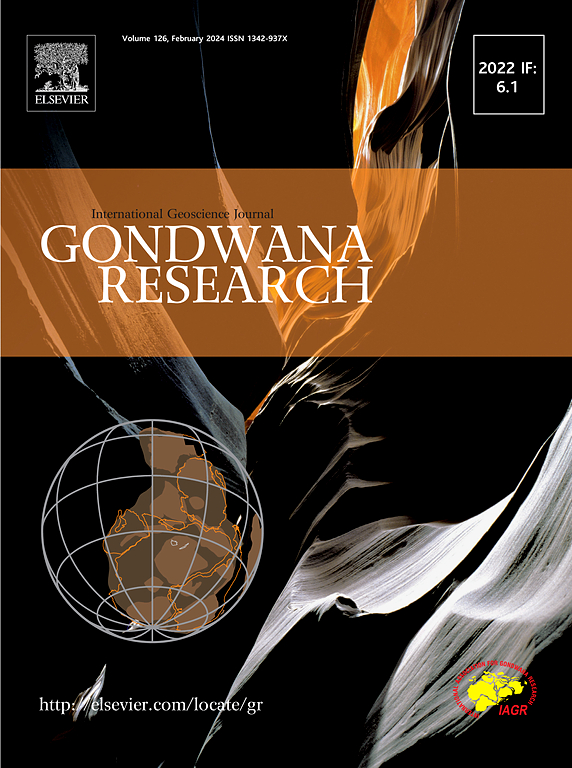Ancient depths: Unprecedented completeness of mesophotic coral-fish ecosystem from the Devonian of Eastern Gondwana
IF 7.2
1区 地球科学
Q1 GEOSCIENCES, MULTIDISCIPLINARY
引用次数: 0
Abstract
Modern mesophotic coral ecosystems (MCEs) are built by zooxanthellate scleractinian corals anatomically adapted (platy growth) to light harvesting at greater depths. Ecosystems of this kind date back to the Silurian (∼430 Ma) and in the Palaeozoic were built by now-extinct tabulate corals. Palaeozoic MCEs were recognized for the first time quite recently, and are still poorly known – only from isolated occurrences on the tropical shelves of palaeocontinents of Laurussia (Silurian, Middle Devonian), with a single example from Western Gondwana (Morocco, Middle Devonian). This study reveals a Lower Devonian (Emsian, ∼395 Ma) coral biostrome at Wee Jasper (New South Wales, Australia; Eastern Gondwana). The area has long been noted for its diverse, well- preserved fossil fish fauna, and the investigated beds, besides corals, are associated with many fish remains, mainly armoured fishes – placoderms. With about 70 species identified so far (placoderms, acanthodians, osteichthyans) this is the most diverse Devonian fish assemblage known to date. We identified a platy tabulate coral (a growth form adapted to low-light conditions) assemblage. Numerous anatomical features of corals (e.g., growth forms, corallite sizes) and fish (e.g., teeth adaptations for herbivory or durophagy) are directly comparable with modern taxa. Along with sedimentological data, the entire assemblage can be interpreted as a MCE. The description of the Wee Jasper MCE highlights numerous functional similarities between Palaeozoic and Recent mesophotic ecosystems, despite major taxonomical differences. Moreover, it suggests a broad distribution of MCEs on tropical shelves of Gondwana as early as the Early Devonian, evidencing proliferation of photosymbiotic, habitat-forming tabulate corals during the reef acme in the middle Palaeozoic. We propose the Wee Jasper MCE as the most complete Palaeozoic coral-fish ecosystem known to date.

古深度:东冈瓦纳泥盆纪的中孔珊瑚-鱼类生态系统空前完整
现代中生代珊瑚生态系统(MCEs)是由在解剖学上适应(板状生长)在更深处采光的动物贝壳硬骨珊瑚建立的。这种生态系统可以追溯到志留纪(430Ma),在古生代则是由现已灭绝的虎斑珊瑚建立的。古生代的 MCEs 是最近才被首次发现的,目前还鲜为人知--仅在劳鲁西亚古大陆(志留纪、中泥盆纪)的热带大陆架上有个别出现,西冈瓦纳(摩洛哥、中泥盆纪)也有一个例子。本研究揭示了位于Wee Jasper(澳大利亚新南威尔士州;东冈瓦纳)的下泥盆统(Emsian,∼395 Ma)珊瑚生物群。长期以来,该地区一直以其种类繁多、保存完好的鱼类化石群而著称,调查的海床中除了珊瑚外,还有许多鱼类遗骸,主要是铠甲鱼类--胎生鱼类。目前已确认的鱼类(胎生类、棘皮动物、骨鱼类)约有 70 种,这是迄今所知泥盆纪鱼类最多样化的组合。我们发现了一个板状塔形珊瑚(一种适应弱光条件的生长形式)组合。珊瑚和鱼类的许多解剖学特征(如生长形式、珊瑚虫大小)(如牙齿适应草食性或黑齿性)可与现代类群直接比较。结合沉积学数据,整个集合体可被解释为一个 MCE。对 Wee Jasper 中生代生态系统的描述凸显了古生代和近代中生代生态系统之间的众多功能相似性,尽管它们在分类学上存在很大差异。此外,它还表明早在泥盆纪早期,中生代生态系统就广泛分布在冈瓦纳热带大陆架上,证明了在古生代中期的珊瑚礁高峰期,光合共生、形成栖息地的塔状珊瑚大量繁殖。我们认为 Wee Jasper MCE 是迄今所知最完整的古生代珊瑚-鱼类生态系统。
本文章由计算机程序翻译,如有差异,请以英文原文为准。
求助全文
约1分钟内获得全文
求助全文
来源期刊

Gondwana Research
地学-地球科学综合
CiteScore
12.90
自引率
6.60%
发文量
298
审稿时长
65 days
期刊介绍:
Gondwana Research (GR) is an International Journal aimed to promote high quality research publications on all topics related to solid Earth, particularly with reference to the origin and evolution of continents, continental assemblies and their resources. GR is an "all earth science" journal with no restrictions on geological time, terrane or theme and covers a wide spectrum of topics in geosciences such as geology, geomorphology, palaeontology, structure, petrology, geochemistry, stable isotopes, geochronology, economic geology, exploration geology, engineering geology, geophysics, and environmental geology among other themes, and provides an appropriate forum to integrate studies from different disciplines and different terrains. In addition to regular articles and thematic issues, the journal invites high profile state-of-the-art reviews on thrust area topics for its column, ''GR FOCUS''. Focus articles include short biographies and photographs of the authors. Short articles (within ten printed pages) for rapid publication reporting important discoveries or innovative models of global interest will be considered under the category ''GR LETTERS''.
 求助内容:
求助内容: 应助结果提醒方式:
应助结果提醒方式:


